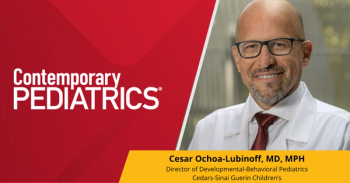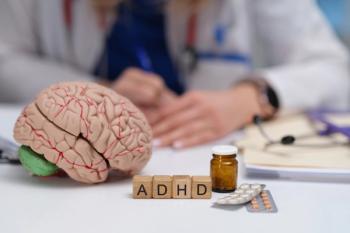
Are we medicalizing “the terrible 2s”?
The Centers for Disease Control and Prevention (CDC) has been monitoring the prevalence of diagnosed and medicated attention-deficit/hyperactivity disorder (ADHD) among children aged 4 to 17 years since 1997, and the evolving data show rates for both measures have been rising steadily and more dramatically in recent years.
The Centers for Disease Control and Prevention (CDC) has been monitoring the prevalence of diagnosed and medicated attention-deficit/hyperactivity disorder (ADHD) among children aged 4 to 17 years since 1997, and the evolving data show rates for both measures have been rising steadily and more dramatically in recent years.
Although articles in the lay press raise concerns that these temporal trends are explained by indiscriminate diagnosis of ADHD and overuse of stimulant medications, child behavioral health experts believe they mostly reflect increased awareness, improved diagnosis, and the increased numbers of adolescents and adults since the realization that ADHD does not disappear at puberty but can continue throughout life.
However, just-reported findings from analyses focusing on the preschool population are generating real worry. Whereas behavior therapy should be first-line treatment for very young children, the data show that among 4- to 5-year-olds as well as in the younger toddler group (ages 2 and 3 years), high numbers of children were receiving medication for ADHD.1
Susanna N. Visser, MS, DrPH, from the CDC collaborated on the preschool project that initially analyzed data from 2012 on ADHD diagnosis and management among 4- to 5-year-olds covered by the Georgia Medicaid program. The project was designed to assess whether treatment of ADHD among these preschoolers was in compliance with available best-practice guidance that clearly states behavior therapy should be the first line of intervention, explains Visser, acting associate director of science, Division of Human Development and Disability, National Center on Birth Defects and Developmental Disabilities, CDC, Atlanta, Georgia.
The study found an ADHD diagnosis prevalence rate of about 5.6% and determined that the majority of children, 74%, were receiving stimulant medication while only 44% were receiving some kind of psychological services that might be behavior therapy.1
Having no expectation for uncovering these remarkable findings but because the data were available, the researchers further explored ADHD diagnosis and treatment among children aged 2 and 3 years. Much to their surprise, the results revealed an ADHD diagnosis prevalence rate of about 1.0% and showed 46% of those children were being given medications, while 45% were receiving psychological services.
In order to explore if the data on 2- to 3-year-olds reflected a phenomenon limited to just the Medicaid population or to the entire state of Georgia, additional analyses were undertaken looking at a private insurance population using a national claims database.1 The results showed a lower overall prevalence of ADHD diagnosis, 0.24%, but nearly the same high rate of ADHD medication use, about 40%.
Speaking to Contemporary Pediatrics, Visser notes the only conclusion that can be reached for now is that the studies documented practice patterns inconsistent with evidence-based guideline recommendations for ADHD management. “The observations indicate a need to ensure healthcare providers are aware of the best practices and for us to try to understand and address barriers to providing behavior therapy,” she says.
Deciphering the data
Visser is careful to observe that these initial data provide only a snapshot on prevalence rates of diagnosed and medicated ADHD among the preschool groups, and that details on context are lacking. However, a number of follow-up analyses are now being conducted to develop insights. The expanded research will look at whether the findings are replicated using data from other patient samples and if there are variations by state. In addition, the investigators will continue looking at patterns by age and will be mining the available data to see whether the medication-treated children were more likely to have co-occurring conditions and if any particular group of physicians (pediatricians, psychiatrists, family practitioners) were predominant medication prescribers. The latter information would help to target educational outreach messages, she explains.
Visser also observes that the finding that diagnosed ADHD was more prevalent in the Medicaid toddler population than among children covered by private insurance was not surprising, considering the latter group has fewer socioeconomic risk factors for ADHD. However, it is important to keep in mind that the circumstances under which the preschool-aged children in the Georgia Medicaid and private insurance populations received medication are not known.
“These may be families in great crisis because of the child’s behavior, and it is important not to conclude that the physicians involved were being flippant with stimulant medication use,” Visser says. “Certainly, quick intervention with medications may be appropriate in some situations. However, those cases should be rare, and the focus should always be to use behavioral therapy first.”
Speaking to the practices of his colleagues, Mark Wolraich, MD, who serves as chair of the American Academy of Pediatrics (AAP) ADHD subcommittee and is CMRI/Shaun Walters Professor of Pediatrics, and chief, Section of Developmental and Behavioral Pediatrics, Oklahoma University Health Sciences Center, Oklahoma City, says he believes most pediatricians are very hesitant about using stimulant medications in very young children.
In terms of the Medicaid data, Wolraich points out that it captures children in the foster care system who may be brought to physicians because their disruptive behavior is increasing the challenges of home placement. Given their living situation and insurance coverage, lack of access to behavior therapy may be a particular issue for these children, while medication that can effectively control their behavior might provide them with an increased chance for a stable home environment.
However, even in other scenarios, providers may be frustrated in trying to assist families in receiving behavioral services because high quality therapy is not always accessible. “It could be that infrastructure deficits underlie reliance on medication treatment in these very young children,” Visser says.
Choosing appropriate treatment
Discussing the AAP’s clinical practice guideline for ADHD,2 Wolraich observes that the Academy recommends medication as first-line treatment for ADHD in children aged 6 years and older, but that clinicians first prescribe evidence-based parent- and/or teacher-administered behavior therapy for preschoolers aged 4 to 5 years. Use of methylphenidate is recommended for preschoolers only if the behavior interventions do not provide significant improvement and there is moderate-to-severe continuing disturbance in the child’s function. If evidence-based behavioral treatments are not available, the guideline recommends clinicians weigh the risk of starting medication at an early age against the harm of delaying diagnosis and treatment.
Explaining the recommendations for preschoolers, Wolraich notes, “In this age group, there is limited research evaluating medications and a lot more evidence demonstrating the efficacy of behavior therapy, especially intervention focusing on parent training. Therefore, it is important to be encouraging parents of these young children with ADHD to get those services. Medication rarely should be considered unless behavior therapy has been tried first.”
The Preschool ADHD Treatment Study (PATS) is the only rigorously designed, multicenter clinical trial investigating use of ADHD medication among preschoolers.3 It randomized 165 children aged 3 to 5.5 years to active treatment or placebo, but included very few 3-year-olds. In addition, participants had to have moderate-to-severe dysfunction, and PATS evaluated only methylphenidate, which is not even approved by the US Food and Drug Administration (FDA) for use in children aged younger than 6 years. (Only the combination drug amphetamine and dextroamphetamine [Adderall] is approved by the FDA for use in children aged younger than 6 years and it is not recommended for children aged younger than 3 years.)
The PATS trial found that children treated with methylphenidate derived some benefit, but also that the adverse effects of treatment, particularly emotional adverse events, were greater in the preschool population than had been reported in school-aged children.
“The AAP ADHD committee used PATS to inform its recommendations on preschoolers and concluded that there are elevated health risks to children who receive ADHD medications at an early age, and that it is a better, more balanced approach to try behavior therapy first. Then, only if significant impairment persists, consider a low dose of methylphenidate with careful titration,” Wolraich says.
Introducing another side of the coin, Michael J. Manos, PhD, head, Center for Pediatric Behavioral Health, Cleveland Clinic, Cleveland, Ohio, notes there is preliminary information from magnetic resonance imaging studies indicating stimulant medication may not have the feared consequences on the brain harbored by many parents. He explains that investigations involving preadolescent and adolescent youth show pharmacotherapy may reduce brain volume deficits associated with ADHD.4
“Perhaps these benefits also occur with medication use in younger children, but that is unknown. And, the changes observed with pharmacotherapy do not mean that medication is a cure for ADHD or for differential brain volumes associated with ADHD,” Manos says. “Based on current understanding of the benefits and potential risks, medication may be appropriate in the interim until behavior therapy begins to produce results in the situation where a child exhibits extreme forms of hyperactivity that [are] highly disruptive and causing damage to the family. However, the main issue is that the child should receive a proper diagnostic evaluation to make sure the behaviors are associated with ADHD and not something else.”
Making the diagnosis
Although the ADHD clinical practice guideline from the AAP does not even reference children aged 2 and 3 years1 and recommendations pertaining to preschoolers in the American Academy of Adolescent and Child Psychiatry practice parameters5 refer to children aged 3 to 5 years, technically there is no lower age limit for diagnosing ADHD. Nevertheless, the experts consider it is extremely difficult if not impossible to diagnose ADHD in very young children because many of the symptoms on which the diagnosis is based are developmentally appropriate.
“That is one reason why the CDC national surveillance program never even looked at ADHD prevalence data for children younger than 4,” Visser says.
Manos also notes that while it may be possible to diagnose ADHD prior to age 3 years, it is almost never done because of the uncertainty of making an accurate diagnosis. In addition to the difficulty in differentiating ADHD symptoms from normal temperamental characteristics, there is overlap between ADHD symptoms and features of potentially coexisting emotional, behavioral, developmental, and physical conditions.
“Even a child who exhibits all the symptoms associated with ADHD may not actually have ADHD,” says Manos. “Many children in this young age group show emotional dysregulation and that may be combined with ineffective parenting that adversely shapes the child’s behavior. Furthermore, there may be co-occurring conditions, such as mood disorders. Any of these issues may be hard to detect, and so even when a child seems to fulfill the diagnostic criteria for ADHD, there is always the uncertainty that the diagnosis is not correct.”
Insubstantial encounter time within the constraints of a short office visit further limits the ability to diagnose ADHD with certainty. Manos believes this inability to conduct a thorough assessment combined with the complexity of the diagnosis may be contributing to ADHD overdiagnosis and, secondarily, to high rates of ADHD medication use.
However, even if ADHD has not been formally diagnosed using set criteria, behavior therapy might be recommended to the family of children exhibiting hyperactive/impulsive behaviors considering its potential for benefit without causing any real harm.
“Studies that have been done evaluating behavioral intervention were not diagnostically specific, and a child does not have to have a set diagnosis before the family is referred for services. The main downsides are that behavior therapy can be frustrating and takes up time,” notes Wolraich.
Advice for clinicians
Manos says that the success of behavior therapy depends on the ability of caregivers to deliver it, and thorough diagnosis is required to clearly define the parameters of treatment. “Clinicians identify target behaviors, determine whether target behaviors are manageable by caregivers, and only then clarify whether pharmacotherapy is needed,” he explains.
Manos urges primary care physicians to refer families to a professional with expertise in developmental and behavioral pediatrics if they feel unable to undertake the evaluation needed to diagnose ADHD and uncover comorbid conditions. The professionals who provide these services are also able to counsel the family on behavioral interventions, he says.
In addition to helping families make proper connections for evaluation and care, Manos notes there are a number of good books on parenting that physicians can recommend. He cites
Recognizing that access to adequate services is a real issue preventing some families from using behavioral intervention, Wolraich urges pediatricians and other professionals involved in the management of these patients to be advocating for more qualified therapists. He suggests speaking to representatives in local and state government and child services agencies as well as working through their local AAP chapter that can help identify available resources for families.
“There is frustration for primary care physicians in not having ready availability of resources for referral,” says Wolraich. “That is particularly true in rural areas and for families and children covered by Medicaid. However, the solution is not to resort to medications,” he advises. “The environment in which the child is being raised is a very important aspect of development, and that is to some extent the focus of behavioral interventions.”
REFERENCES
1. Visser SN. IDT Collaboration-Georgia Medicaid Data Analyses: Implementing the IDT strategic plan and unpacking the GA data among young children in GA. Presented at: The State of ADHD Care in Georgia: From Data to Action, Georgia Mental Health Forum; May 16, 2014; Atlanta, Georgia.
2. Subcommittee on Attention-Deficit/Hyperactivity Disorder; Steering Committee on Quality Improvement and Management, Wolraich M, Brown L, Brown RT, et al. ADHD: clinical practice guideline for the diagnosis, evaluation, and treatment of attention-deficit/hyperactivity disorder in children and adolescents. Pediatrics. 2011;128(5):1007-1022.
3. Greenhill L, Kollins S, Abikoff H, et al. Efficacy and safety of immediate-release methylphenidate treatment for preschoolers with ADHD. J Am Acad Child Adolesc Psychiatry. 2006;45(11):1284-1293. Erratum in: J Am Acad Child Adolesc Psychiatry. 207;46(1):141.
4. Ivanov I, Murrough JW, Bansal R, Hao X, Peterson BS. Cerebellar morphology and the effects of stimulant medications in youths with attention deficit-hyperactivity disorder. Neuropsychopharmacology. 2014;39(3):718-726.
5. Pliska S; AACAP Work Group on Quality Issues. Practice parameter for the assessment and treatment of children and adolescents with attention-deficit/hyperactivity disorder. J Am Acad Child Adolesc Psychiatry. 2007;46(7):894-921.
Ms Krader has 30 years of experience as a medical writer. She has worked as both a hospital pharmacist and a clinical researcher/writer for the pharmaceutical industry and is presently a freelance writer in Deerfield, Illinois. She has nothing to disclose in regard to affiliations with or financial interests in any organizations that may have an interest in any part of this article.
Newsletter
Access practical, evidence-based guidance to support better care for our youngest patients. Join our email list for the latest clinical updates.









